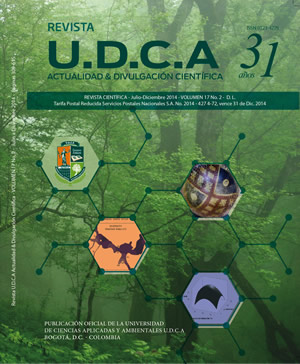Características de cultivos celulares primarios derivados de Sarconesiopsis magellanica (Le Guillou, 1842) (Diptera: Calliphoridae)
Primary cell cultures derived from Sarconesiopsis magellanica (Le Guillou, 1842) (Diptera: Calliphoridae)
Contenido principal del artículo
Resumen
El objetivo principal del presente trabajo fue obtener cultivos celulares primarios derivados de tejido embrionario de Sarconesiopsis magellanica (Diptera: Calliphoridae), mosca importante por sus aplicaciones en el establecimiento del intervalo post-mortem. Se evaluaron siete medios de cultivo (Grace, Grace/L15, MM, VP12, MM/VP12, Eagle y Schneider), suplementados con 20% de suero fetal bovino. Se observó adhesión, crecimiento y proliferación celular en los medios L15, Schneider y Grace/L15, lográndose mejores resultados en los dos últimos. La obtención de la monocapa confluente, se presentó en un tiempo promedio de doce días, después de realizados los explantes. El patrón de crecimiento de los cultivos primarios mostró la presencia de vesículas con células adheridas a sus paredes, las cuales, ayudaron a la formación de la monocapa confluente. La morfología celular predominante en la monocapa correspondió a formas fibroblastoides y, en menor proporción, a epitelioides, mostrando las primeras una apariencia similar a células nerviosas. Adicionalmente, se registraron en los primeros días de los cultivos primarios, especialmente, en algunos conglomerados de células, movimientos contráctiles semejantes a los realizados por células musculares. Estos cultivos celulares primarios derivados de S. mangellanica representan, potencialmente, sustratos adecuados para realizar ensayos posteriores de susceptibilidad a infección con arbovirus y parásitos.
Palabras clave:
Descargas
Datos de publicación
Perfil evaluadores/as N/D
Declaraciones de autoría
- Sociedad académica
- Universidad de Ciencias Aplicadas UDCA
- Editorial
- Universidad de Ciencias Aplicadas y Ambientales U.D.C.A
Detalles del artículo
Referencias (VER)
ARDILA, A.; ESCOVAR, J.; BELLO, F. 2005. Características de nuevos cultivos celulares derivados de tejidos embrionarios de Aedes aegypti (Diptera: Culicidae). Biomédica (Colombia). 25(1):65-75.
BELLO, F.; RODRÍGUEZ, J.; MORALES, A.; OLANO, V. 1999. Estudio de cultivos celulares primarios de Psorophora confinnis (Diptera: Culicidae). Biomédica (Colombia). 19(2):127-135.
BELLO, F.; RODRÍGUEZ, J.; ESCOVAR, J.; OLANO, V.; MORALES, A.; GONZÁLEZ, M.; REY, G. 2001. A new continuous cell line from the mosquito Psorophora confinnis (Diptera: Culicidae) and its susceptibility to infections with some arboviruses. Mem. Inst. Oswaldo Cruz (Brasil). 96(6):865-873.
CHARPENTIER, G.; BELLONCIK, S.; DUCROS, G.; FONTENILLE, D.; TIAN, L.; QUIOT, J. 1995. Establishment and characterization of three cell lines from Aedes triseriatus (Diptera: Culicidae). J. Med. Entomol.(Estados Unidos). 32(6):793-800.
CÔRTES, L.; SILVA, R.; PEREIRA, B.; GUERRA, C.; ZAPATA, A.; BELLO, F.; FINKELSTEIN, L.; MADEIRA, M.; BRAZIL, R.; CÔRTE-REAL, S.; ALVES, C. 2011. Lulo cell line derived from Lutzomyia longipalpis (Diptera: Psychodidae): a novel model to assay Leishmania spp. and vector interaction. Parasit. Vectors (Inglaterra). 4:216- 220.
ECHEVERRY, L.; ZAPATA, A.; SEGURA, A.; BELLO, F. 2009. Estudio de cultivos celulares primarios derivados de Lucilia sericata (Diptera: Calliphoridae). Rev. Cienc. Salud (Colombia). 7(3):17-28.
FERREIRA, M.J.M.; BARBOLA, I.F. 1998. Sinantropía de Califorídeos (Insecta, Diptera) de Curitiba, Paraná, Brasil. Rev. Bras. Biol 58 (2): 203-209.
FIGUEROA, L.; FLORES, J.; RODRÍGUEZ, S. 2007. Método de cultivo de larvas de Lucilia sericata para terapia larval. Parasitol. Latinoam. (Chile). 62:79-82.
FÖRSTER, M.; KLIMPEL, S.; MEHLHORN, H.; SIEVERT, K.; MESSLER, S.; PFEFFER, K. 2007. Pilot study on synanthropic flies (e.g. Musca, Sarcophaga, Calliphora, Fannia, Lucilia, Stomoxys) as vectors of pathogenic microorganisms. Parasitol Res. 101:243-246.
GOODMAN, C.L.; STANLEY, D.; RINGBAUER, J.A. Jr.; BEEMAN, R.W.; SILVER, K.; PARK, Y. 2012. A cell line derived from the red flour beetle Tribolium castaneum (Coleoptera: Tenebrionidae). In Vitro Cell Dev Biol Anim. PMID: 22752637 [Epub ahead of print].
GRACE, T. 1962. Establishment of four strains of cells from insect tissues grown in vitro. Nature (Inglaterra). 195:788-789.
GRASELA, J.; MCINTOSH, A.; RINGBAUER, J.; JR, GOODMAN, C.; CARPENTER, J.; POPHAM, H. 2012. Development of cell lines from the cactophagous insect: Cactoblastis cactorum (Lepidoptera: Pyralidae) and their susceptibility to three baculoviruses. In Vitro Cell Dev. Biol. Anim. (Alemania). 48(5):293-300.
HARRISON, R.; LYNN, D. 2008. New cell lines derived from black cutworm, Agrotis ipsilon, that support replication of the A. ipsilon multiple nucleopolyhedrovirus and several group I nucleopolyhedroviruses. J. Invertebr Pathol (Estados Unidos). 99(1):28-34.
HINK, W.; THOMSEN, D.; DAVIDSON, D.; MEYER, A.; CASTELLINO, F. 1991. Expression of three recombinant proteins using baculovirus vectors in 23 insect cell lines. Biotech. Prog. (Estados Unidos). 7(1):9-14.
HOSHINO, K.; HIROSE, M.; IWABUCHI, K. 2009. A new insect cell line from the longicorn beetle Plagionotus christophi (Coleoptera: Cerambycidae). In Vitro Cell Dev. Biol. Anim. 45(1-2):19-22.
IKONOMOU, L.; BASTIN, G.; SCHNEIDER, Y.; AGATHOS, S. 2001. Design of an efficient medium for insect cell growth and recombinant protein production. In Vitro Cell Dev. Biol. Anim. 37(9):549-559.
INOUE, H.; KOBAYASHI, J.; KAWAKITA, H.; MIYAZAKI, J.; HIRABAYASHI, T. 1991. Insect muscle cell line forms contractile tissue networks In vitro. In Vitro Cell Dev. Biol. 27A(11):837-840.
IWANAGA, M.; ARAI, R.; SHIBANO, Y.; KAWASAKI, H.; IMANISHI, S. 2009. Establishment and characterization of the Bombyx mandarina cell line. J. Invertebr. Pathol. 101(2):124-129.
KHARAT, K.; SAWANT, M.; PETER, S.; HARDIKAR, B. 2010. Development and characterization of new cell line BPH22 from midgut epithelial cells of Poekilocerus pictus (Fabricius, 1775). In Vitro Cell Dev.Biol. Anim. 46(10):824-827.
KHURAD, A.; ZHANG, M.; DESHMUKH, C.; BAHEKAR, R.; TIPLE, A.; ZHANG, C. 2009. A new continuos cell line from larval ovaries of silkworm, Bombyx mori. In Vitro Cell Dev. Biol. Anim. 45(8):414-419.
LE DOUARIN, N. 1971. Organ culture methods. En: Vago, C. (ed.) Invertebrate tissue culture. Volume I. Nueva York: Academic Press. p.41-114.
LI, X.; QIN, Q.; ZHANG, N.; ZHU, W.; ZHANG, J.; WANG, H.; MIAO, L.; ZHANG, H. 2012. A new insect cell line from pupal ovary of Spodoptera exigua established by stimulation with N-methyl- N'-nitro-N-nitrosoguanidine (MNNG). In Vitro Cell Dev. Biol. Anim. 48(5):271-275.
LYNN, D. 2002. Methods for maintaining insect cell cultures. J. Insect. Sci. (Estados Unidos). 2(9):1-6.
LYNN, D. 2001. Novel techniques to establish new insect cell lines. In vitro Cell Dev. Biol. 37(6):319-321.
LYNN, D. 2007. Available lepidopteran insect cell lines. In: Murhamme D. (ed.) Methods in molecular biology: baculoviruses and insect cell expression protocols, vol. 338 2nd ed. Humana, Totowa, New Jersey. p.117-137.
MARILUIS, J.; MULIERI, P. 2003. The distribution of the Calliphoridae in Argentina (Diptera). Rev. Soc. Entomol. Argent. 62(1):85-97.
MARILUIS, J.; SCHNACK, J. 1996. Elenco específico y aspectos ecológicos de Calliphoridae (Insecta, Diptera) de San Carlos de Bariloche, Argentina. Bol. R. Soc. Esp. Hist. Nat. Secc. Biol. 92(1-4):203-213.
MARTÍNEZ, E.; DUQUE, P.; WOLFF, M. 2007. Succession pattern of carrion-feeding insects in Paramo, Colombia. Forensic Sci. Int. (Irlanda).166(2-3):182-189.
MENA, J.A.; KAMEN, A.A. 2011. Insect cell technology is a versatile and robust vaccine manufacturing platform. Expert Rev Vaccines. 10(7):1063-1081.
MIRANDA, A.; SARMIENTO, L.; CALDAS, M.; ZAPATA, C.; BELLO, F. 2008. Morfología y citoquímica de cultivos celulares de Aedes aegypti (Diptera: Culicidae) y susceptibilidad a Leishmania panamensis (Kinetoplastida: Trypanosomatidae). Rev. Biol. Trop. (Costa Rica). 56(2):447-458.
MITSUHASHI, J.; MARAMOROSH, K. 1964. Leafhopper tissue culture: embryonic, nymphal and imaginal tissues from aseptic insects. Contrib Boyce Thompson Inst (Estados Unidos). 22:435-460.
OELOFSEN, M.; GERICKE, A.; SMITH, M.; VAN DER LINDE, T. 1990. Establishment and characterization of a cell line from the mosquito Culex (Culex) theileri (Diptera: Culidae) and its susceptibility to infection with arbovirus. J. Med. Ent. (Estados Unidos). 27(6):939-944.
MONTOYA, A.; SANCHEZ, J.; WOLFF, M. 2009. Sinantropía de Calliphoridae (Diptera) del Municipio La Pintada, Antioquia - Colombia. Rev. Colomb. Entomol. 35(1):73-82.
PAN, M.; CAI, X.; LIU, M.; LV, J.; TANG, H.; TAN, J.; LU, C. 2010. Establishment and characterization of an ovarian cell line of the silkworm. Bombyx mori. Tissue cell. (Estados Unidos). 42(1):42-46.
PAPE, T.; WOLFF, M.; AMAT, E. 2004. Los Califóridos, Éstridos, Rinofóridos y Sarcofágidos (Diptera: Calliphoridae, Oestridae, Rhinophoridae, Sarcophagidae) de Colombia. Biota Colomb. 5(2): 201-208.
PINILLA, Y.; SEGURA, A.; BELLO, F. 2012. Synanthropy of Calliphoridae and Sarcophagidae (Diptera) in Bogotá, Colombia. Neotrop Entomol (Brasil). 41(3):237-242.
REY, G.; FERRO, C.; BELLO, F. 2000. Establishment and characterization of a new continuous cell line from Lutzomyia longipalpis (Diptera: Psychodidae) and its susceptibility to infections with arboviruses and Leishmania chagasi. Mem. Inst. Oswaldo Cruz (Brasil). 95(1):103-110.
SEGURA, N.; USAQUÉN, W.; SÁNCHEZ, M.; CHUAIRE, L.; BELLO, F. 2009. Succession pattern of cadaverous entomofauna in a semi-rural area of Bogotá, Colombia. Forensic Sci. Int. (Irlanda). 187(1-3):66-72.
SEGURA, N.; SANTAMARÍA, E.; CABRERA, O.; BELLO, F. 2012. Establishment and characterisation of a new cell line derived from Culex quinquefasciatus (Diptera: Culicidae). Mem. Inst. Oswaldo Cruz. 107(1):89-95.
STEVENS, J.R. 2003. The evolution of myiasis in blowflies (Calliphoridae). Int. J. Parasitol. 33:1105-1113.
SUDDEP, A.; KHUSHIRAMANI, R.; ATHAWALE, S.; MISHRA, A.; MOURYA, D. 2005. Characterization of a newly established potato tuber moth (Phthorimaea operculella Zeller) cell line. Indian J. Med. Res. 121(3):159-163.
TAKAHASHI, M.; MITSUHASHI, J.; OHTAKI, T. 1980. Establishment of a cell line from embryonic tissues of the fleshfly, Sarcophaga peregrine (insect: Diptera). Developm., Growth Differ. (Japón). 22(1):11-19.
VARMA, M.; PUDNEY, M. 1969. The growth and serial passage of cell lines from Aedes aegypti (L) larvae in different media. J. Med. Entomol. (Estados Unidos). 6(4):432-439.
VISCIARELLI, E.C.; GARCÍA, S.H.; SALOMÓN, C.; JOFRÉ, C.; COSTAMAGNA, S.R. 2003. Un caso de miasis humana por Cochliomyia hominivorax (Diptera: Calliphoridae) asociado a pediculosis en Mendoza, Argentina. Parasitol. Latinoam. 58:166- 168.
WEN, F.; ZHANG, Y.; QU, L.; ZHANG, H.; YANG, Z.; QIN, Q.; WANG, Y.; WANG, W. 2009. Two new cell lines originated from the embryos of Clostera anachoreta (Lepidoptera: Notodontidae): characterization and susceptibility to baculoviruses. In Vitro Cell. Dev. Biol. Anim. 45(8):409-413.
WU, C.; WANG, C. 2006. New cell lines from Lymantria Xylina (Lepidoptera: Lymantriidae): Characterization and susceptibility to baculoviruses. J. Invertebr. Pathol. 93(3):186-191.
XU, F.; LYNN, D.; ROODE, E.; MUÑOZ, D.; VAN LENT, J.; VLAK, J.; VAN OERS, M. 2010. Establishment of a cell line from Chrysodeixis chalcites permissive for Chrysodeixis chalcites and Trichoplusia ni nucleopolyhedrovirus. J. Invertebr. Pathol. 105(1):56-62.
ZAPATA, A.; CÁRDENAS, E.; BELLO, F. 2005. Characterization of cell cultures derived from Lutzomyia spinicrassa (Diptera: Psychodidae) and their susceptibility to infection with Leishmania (Viannia) braziliensis. Med. Sci. Monit. (Estados Unidos).11(12):457-464.
ZHANG, X.; FENG, Y.; DING, W.; CHEN, X.; WANG, C.; MA, T. 2011. Establishment and characterization of an embryonic cell line from Gampsocleis gratiosa (Orthoptera: Tettigoniidae). In Vitro Cell. Dev. Biol. Anim. 47(4):327-332.
ZHANG, X.; FENG, Y.; DING, W.; CHEN, X.; WANG, C.; MA, T. 2012. Characterization of a new insect cell line that is derived from the neonate larvae of Papilio xuthus (Lepidoptera: Papilionidae) and its susceptibility to AcNPV. Tissue Cell. (Inglaterra). 44(3):137-142.







